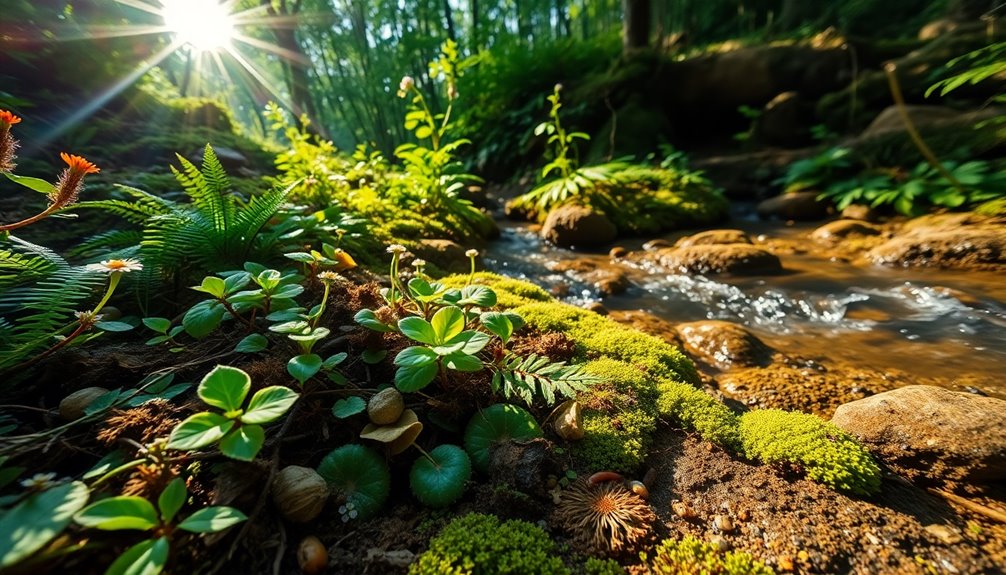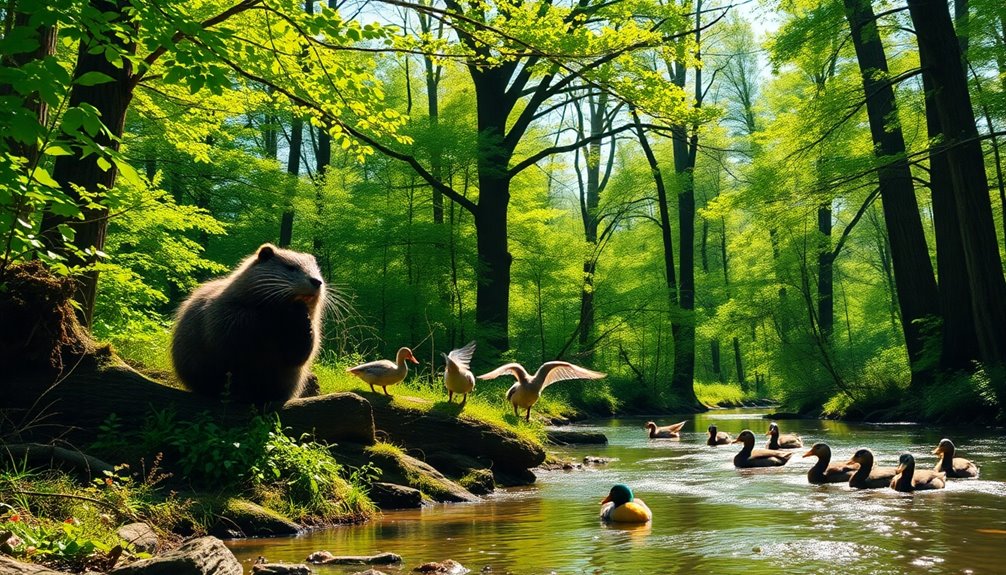Biodiversity contributes to a habitat's sustainability because it helps ecosystems recover from disturbances and maintain essential functions. When one species is affected, others can step in, ensuring stability. A diverse range of plants and animals supports nutrient cycling, improves soil health, and provides crucial services like pollination and pest control. Plus, keystone species play critical roles in maintaining habitat stability. Want to explore how these aspects work together to protect our environment?
Key Takeaways
- Biodiversity enhances ecosystem resilience, allowing habitats to withstand disturbances and adapt to changing conditions.
- A variety of species supports nutrient cycling, improving soil health and overall ecosystem function.
- Diverse food webs maintain stability, ensuring ecological functions persist even when certain species are affected.
- Keystone species play a critical role in maintaining habitat health, influencing biodiversity and ecosystem stability.
- Healthy ecosystems with high biodiversity are better at carbon sequestration, contributing to climate change mitigation and sustainability.
The Role of Biodiversity in Ecosystem Resilience

Biodiversity plays an essential role in ecosystem resilience, as it allows various species to perform similar ecological functions. When you have a rich variety of life, ecosystems can better withstand disturbances like climate change, ensuring their stability.
High biodiversity means that if one species is affected, others can step in to maintain the food web, preventing collapse. Healthy ecosystems thrive with diverse species, which aids in crucial processes like nutrient cycling and carbon sequestration.
This interconnectedness helps them recover quickly from natural disasters or human impacts. Ultimately, the resilience provided by biodiversity not only supports ecosystem functionality but also enhances their ability to adapt to changing conditions, securing a sustainable future for all living organisms.
Importance of Nutrient Cycling and Ecosystem Services

The interconnectedness of species within an ecosystem not only bolsters resilience but also underpins nutrient cycling and various ecosystem services. High biodiversity enhances nutrient cycling, as different plants and animals contribute uniquely to soil health through processes like decomposition and nitrogen fixation.
This efficiency leads to increased food production, essential for both human agriculture and sustaining food webs. Additionally, diverse ecosystems provide important services such as pest control and pollination, reducing the need for chemical inputs and promoting sustainable development.
The presence of varied plant species maintains soil structure and prevents erosion, further supporting habitat sustainability. Furthermore, nutrient cycling supports fundamental ecosystem services like water purification and climate regulation, ensuring the long-term health of habitats and their biological diversity.
Contributions to Food Web Stability

When ecosystems thrive with a variety of species, they create intricate food webs that enhance stability and resilience. High biodiversity guarantees that ecological functions are upheld, even when climate change or other disturbances impact certain species.
In diverse ecosystems, if one species declines, others can step in, maintaining the balance and preventing collapse. This redundancy supports food webs, allowing alternative food sources to support various organisms. For example, multiple pollinator species can guarantee effective crop pollination, reducing the risk of agricultural productivity loss from a single species' decline.
Ultimately, greater biodiversity fosters resilience, enabling ecosystems to adapt and recover from disturbances while maintaining carbon cycling and other critical processes essential for long-term sustainability.
Keystone Species and Their Impact on Habitat Health

Recognizing the role of keystone species is essential for understanding habitat health, as these organisms greatly influence their ecosystems. Keystone species, like sea otters in marine ecosystems, maintain ecosystem stability by controlling populations, such as sea urchins. Their absence can trigger biodiversity loss, leading to habitat degradation.
For instance, the removal of wolves in Yellowstone resulted in overpopulation of elk, harming vegetation. Protecting these significant species enhances biodiversity conservation efforts, allowing habitats to better withstand environmental changes.
Healthy populations of keystone species also contribute to nutrient cycling and food web stability, which are crucial for mitigating carbon dioxide and greenhouse gases. By safeguarding keystone species in protected areas, you help guarantee the resilience of entire ecological communities.
The Interconnection Between Biodiversity and Climate Change Mitigation

Biodiversity plays a crucial role in mitigating climate change, as healthy ecosystems can absorb and store significant amounts of carbon dioxide. By enhancing ecosystem resilience, diverse natural habitats withstand and recover from climate impacts, promoting long-term habitat sustainability.
| Ecosystem Type | Carbon Sequestration Rate |
|---|---|
| Forests | High |
| Peatlands | Twice that of forests |
| Mangroves | Four times that of forests |
| Grasslands | Moderate |
| Marine Ecosystems | Variable |
Protecting and restoring these ecosystems can provide substantial mitigation potential against climate change. For instance, safeguarding forests could offer up to two-thirds of nature's necessary contributions. Ultimately, fostering biodiversity is essential not just for the planet, but for our collective future.
Frequently Asked Questions
How Does Biodiversity Contribute to Sustainability?
Biodiversity contributes to sustainability by ensuring ecosystems function effectively.
When you have a variety of species, each one plays a unique role, helping to maintain balance in food webs and nutrient cycling. This diversity boosts resilience, allowing ecosystems to adapt to changes and recover from disturbances.
Plus, with more species, you get increased ecosystem services, like pollination and water purification, which are essential for supporting both natural environments and human livelihoods.
Why Does Biodiversity Contribute to a Habitat's Sustainability Options?
"Variety's the spice of life," and that holds true in ecosystems too.
Biodiversity contributes to habitat sustainability by creating a balanced environment where different species interact and support each other. When you have a mix of plants and animals, they share resources and cope with changes together.
This diversity helps maintain soil health and nutrient cycling, ensuring survival even when faced with challenges like climate change. It's a safety net for the entire ecosystem.
How Does Habitat Diversity Contribute to the Sustainability of the Ecosystem?
Habitat diversity plays an essential role in sustaining ecosystems by offering various niches for species to thrive.
When you have different habitats, it allows numerous organisms to coexist, enhancing resilience against environmental changes. This diversity promotes complex food webs, which stabilize ecosystems and reduce collapse risks.
Additionally, diverse habitats support vital services like pollination and nutrient cycling, ensuring the system remains productive and efficient over time, ultimately benefiting both wildlife and human well-being.
What Are 5 Reasons Why Biodiversity Is Important?
Biodiversity's important for several reasons.
First, it boosts ecosystem resilience, helping habitats recover from disturbances.
Second, it enhances nutrient cycling, maintaining soil health.
Third, diverse species create complex food webs, ensuring stability if one species declines.
Fourth, biodiversity supports crucial ecosystem services like pollination and climate regulation.
Finally, it preserves resources essential for human survival, such as food and clean water.
Without biodiversity, ecosystems struggle to thrive, impacting both nature and humanity.
Conclusion
In a world buzzing with life, biodiversity is like a vibrant tapestry, weaving together the threads of resilience and stability. When you stroll through a lush forest or a thriving coral reef, you can feel how every species plays its part, ensuring the habitat's health. As you breathe in the rich air, remember that this intricate web of life not only nourishes the planet but also shields it against the storms of change, making our Earth a more sustainable home.









